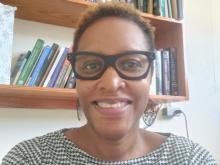Dr Petrea Facey
Lecturer, Organic Chemistry

Telephone: 868-662-2002
Email: petrea.facey@sta.uwi.edu
Research Interests
Endophytes are bacterial or fungal microorganisms, which spend the whole or part of their life cycle inside the healthy tissues of the host plant, typically causing no apparent symptoms of the disease. The relationship between the endophyte and its host plant may range from latent phytopathogenesis to mutualistic symbiosis. That is, the endophytes get nutrition and protection from the host plant and in return, they protect the host plant by producing certain functional metabolites. Mangrove plants are of interest as they are assemblages of salt-tolerant coastal trees which widely found here in the Caribbean.
The coastlines of Trinidad and Tobago are home to seven mangrove species: Rhizophora mangle, Rhizophora harrisonii, Rhizophora racemosa, Avicennia germinans, Avicennia schaueriana, Laguncularia racemosa and Conocarpus erectus. Our research focuses on the investigation of endophytic fungi associated with these mangroves as well as other endemic plants for the presence of novel and/or interesting biologically active compounds. These extracts are subjected to activity-guided isolation studies in order to locate the bioactive components. The purified compounds are then further characterized using modern spectroscopic methods such as 1D and 2D NMR, infrared spectroscopy and where possible, single-crystal X-ray crystallography.
Selected Publications
Chapter in Books:
- Bartnik, M and Facey, P. (2016): Glycosides. In: Pharmacognosy: Fundamentals, Applications and Strategy; Badal McCreath, S.; Delgoda, R.; Eds.: Elsevier, Philadelphia, USA, pp 101-161.
Journal Articles:
- Talontsi, F.M; Facey, P.; Tatong, M.D.K.; Islam, Md. T.; Frauendorf, H.; Draeger, S.; von Tiedemann,A.; Laatsch, H. “Zoosporicidal metabolites from an endophytic fungus Cryptosporiopsis sp. of Zanthoxylum leprieurii.” Phytochemistry, 2012, 83, 87-94.
- Talontsi, F. M.; Islam, Md. T.; Facey, P.; Douanla-Meli, C.; von Tiedemann, A.; Laatsch, H. “Depsidones and other constituents from Phomopsis sp. CAFT69 and its host plant Endodesmia calophylloides with potent inhibitory effect on motility of zoospores of grapevine pathogen Plasmopara viticola.” Phytochemistry Letters, 2012, 5, 657-664.
- McCook-Russell, K. P.; Nair, M. G.; Facey, P. C.; Bowen-Forbes, C. S. “Nutritional and nutraceutical comparison of Jamaican Psidium cattleianum (strawberry guava) and Psidium guajava (common guava) fruits.” Food Chemistry, 2012, 134, 1069–1073. (Impact Factor- 4.052)
- McNeil, M.; Facey, P.; Porter, R. “Essential oils from the Hyptis genus-a review (1909-2009).” Nat. Prod. Commun. 2011, 6, 1775-96.
- Facey, P. C.; Peart, P.; Porter, R. B. “Antimicrobial activities of Mikanolide and its derivatives.” West Indian Med. J., 2010, 59, 249-252.
- Vouffo, B.; Dongo E.; Facey, P.; Thorn, A.; Sheldrick, G.; Laatsch, H. “Antiarol cinnamate and Africanoside, a cinnamoyl triterpene and a hydroperoxy-cardenolide from the stem bark of Antiaris africana (Moraceae).” Planta Med., 2010, 76, 1-7.
- Shaaban, K. A.; Shaaban, M.; Facey, P.; Fotso, S.; Helmke, E.; Laatsch, H. “γ-Butyrolactone and Electrospray Ionization-Mass Spectra of Piperazimycins A-B from Marine-derived Actinomycete sp.” J. Antibiot., 2008, 61, 736-746.
Qualifications
- Alexander von Humboldt Fellow 2007
- Ph.D. Chemistry, UWI, Mona 2006
- B.Sc. Special Chemistry, UWI Mona 1995










